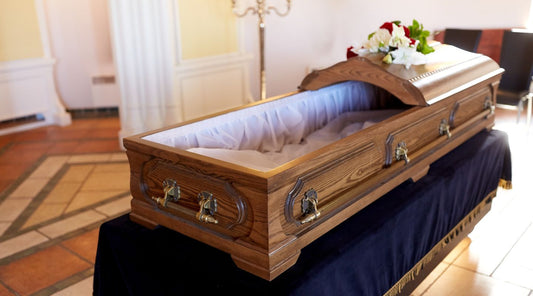
To Use or Not to Use a Burial Vault- A Complete Guide on Burial Vaults
In today's world of financial consciousness, more and more people are sitting on the fence about the amount of money they're willing to pay for a funeral. Adding a burial vault doesn't seem that important or necessary anymore.
Most of the time, people attending a funeral don’t even get to see the burial vault (it’s only the people working at the cemetery and digging the grave). Therefore, spending somewhere between $500 and $1,000 for a burial vault doesn’t come easy to many. It almost doesn’t surprise anybody when people ask themselves if they really need to use a burial vault or not?
Even if the question isn’t complicated, the answer is quite tricky. It depends a lot on the circumstance of the burial, but you should learn all the details on burial vault before making a call.
How to describe the burial vault briefly?
The burial vault is a tough recipient of concrete, hard plastic, metal, or some material that will not degrade any time soon. It's placed inside the grave before the casket. It's supposed to ensure support for the coffin, and protect the casket and the body against the elements.
Burial vaults are complete recipients, unlike the burial liners. The latter is also made with metal, hard plastic, or concrete, but don't feature a bottom wall. When using a burial liner, the casket will still lie upon the bare ground, but the three walls around it would protect it.
We should highlight that funeral directors aren’t supposed to sell you burial vaults (or liners) as products that will sustain the preservation of the body in the grave. Should a cemetery or funeral home salesperson will present such a claim, he/she will actually violate federal law. The easiest thing for you to do is to not go with that seller.
In all fairness, burial vaults won’t allow dirt to fall upon the caskets they can even slow down the decomposition process. However, the bacteria and the elements that lead to decomposition aren't going to be eliminated for good. Needless to say, the humid-but-airtight conditions inside the burial vault will accelerate the decay process of the body inside the casket.
The primary purpose of a burial vault is to provide protection, stopping the ground above from caving in around the casket, which otherwise will create sinkholes all across the cemetery. Therefore, the burial vault acts instead as a landscaping tool. It's why many cemeteries will install burial vaults in every grave. They will include the vault price in the price for the burial plots, eliminating the possibility for the customer not to use a burial vault.
Are there situations when the burial vault is a must?
Should the cemetery require the use of burial vault, it makes perfect sense that you have to buy it. In such a situation, you should look for another graveyard that doesn't require you to use a burial vault.
Sometimes (mostly in coastal regions where the ground is typically unstable and wet), almost every cemetery is going to require you to use a burial vault. If you don’t want to buy a burial vault, you will need to look for/found a small family cemetery as there are no rules about using the burial vault. However, keep in mind that not using a burial vault in such regions (where it’s necessary), the risk for developing landscaping problems is high. Burial vaults are eliminating the risk of such issues.
Can the burial vault be optional?
If the region where you bury the deceased is high above sea level, the soil is typically stable enough, so there’s no specific need for burial vaults. If the sale person still claims that you cannot do it without a burial vault, it’s better that you go with another cemetery. The burial vault usually not used for green burials or for immediate burial(home funeral service).
Sometimes, burial vaults are helpful in cemeteries where heavyweight equipment is driven regularly straight over the gravesites. According to the experts, a grave without a vault will be capable of taking pressure up to 4,000 pounds being driven over, but it's only occasionally. When the grave has to handle a lot more pressure regularly, it's better that you also use a burial vault.
You should also think about using a burial vault if there's a chance of having to exhume or move the grave sometimes in the future. Even if the burial isn't going to stop the decomposition, it can maintain the casket in a shape that allows movement at some point. It's an essential aspect to consider when the burial takes place in an urban cemetery. It’s because there’s a possibility of being sold to any developers for developing economic activity. In that case, the chance of having to mode the grave is quite high, making the burial vault more than necessary.
Can the burial vault become an obstacle?
It makes perfect sense that you shouldn’t use a burial vault when the deceased left firm instruction about the concern for the environment. Most burial vaults will last for a couple of centuries, so anyone wanting to return to nature and opting for biodegradable casket shouldn't be put in a burial vault.
One important aspect to remember about the burial vaults is that they have limitations on the body’s decomposition. They will, however, protect the casket (even the biodegradable coffins) for many years/centuries to come.
Should one utilize a burial vault or a grave liner?
Should you look into funeral terminology, you will eventually meet both the terms burial vaults and grave liners. However, they are both outer burial recipient enclosing the coffin in the grave. Anyone interested in a ground burial will probably have to use a burial vault or a grave liner, along with the coffin.
There are many similarities between the two, as they both support the soil around the casket. They're a tool that reduces/eliminates the risk of earth above and around the casket to collapse. Burial vaults and grave liners are a way to keep the cemetery in good shape and to make it look nice too.
Are the basic features similar?
Both burial vaults and grave liners are outer containers to keep the casket. However, the burial vault will contain the coffins entirely, becoming like a casket for the casket per se.
On the other hand, the grave liner will protect only the sides and the top of the casket, leaving the bottom of the casket in contact with the ground.
Are the same materials used for construction?
Nine times out of ten, concrete is the material used for making burial vaults and grave liners. They're also lined with metal or plastic. Bronze, copper, or steel can also be used for both burial vaults and grave liners.
Can you use burial vaults for cremated remains?
Even though there are many possibilities of keeping/using the cremated remains, some choose to bury the cremated remains in the cemetery. Should that be the case for you, it's essential to know that the cemetery will most likely require you to use a burial vault or at least a grave liner.
Having said that, we should also note that cemeteries have different regulations. However, the majority of burial vaults or grave liners for the cremated remains aren’t as big as the ones used for burial. After all, they only need to protect an urn and not a casket. The smaller size also means lower prices, so make sure you look into it before deciding.
Where can you buy a burial vault?
Most of the time, you will buy the burial vault (or the grave liner) from the funeral home that you’ve hired. You can also buy it from the cemetery.
Unlike the caskets, there aren't many options when it comes to burial vaults, and there are cemeteries that only offer just one type of burial vault. Anyone interested in buying a burial vault but isn't happy with the options can check other retailers until it finds the perfect model.
We should also remind you that the The FTC Funeral Rule doesn’t apply to cemeteries. Therefore, the cemeteries are legal to ask for a fee when using a burial vault/grave liner that you bought elsewhere.
It's possible to buy a burial vault online, but don't forget that burial vaults are very heavy. You may end up paying more due to the incredibly high shipping fees.
As for the price, it shouldn’t surprise you that burial vaults are pricier than the grave liners (they are made with more material!). You can pay somewhere between $700 to $1500 for a grave liner, whereas a burial vault’s price ranges from $900 to $2500. However, some burial vaults can get as high as $10,000.
Instead of a conclusion
Even if you’re not legally required to buy a grave liner or a burial vault, the majority of cemeteries will still ask you to use one. When a burial vault isn’t what you want, the green burial ground is an alternative for burying the remains.
Typically, the burial vaults are advertised as the better option, which is why the cemeteries and funeral homes recommend you to buy one and not a grave liner. With burial vaults being more expensive than the grave liners, it’s understandable why the policy (after all, it’s a business for them). Don’t forget that both burial vaults and grave liners will protect the soil around the casket for making the cemetery look nice. You shouldn’t feel guilty for not buying the burial vault but the grave liner.
Don’t forget to ask for a list of prices for both the burial vaults and the grave liners, as it’s going to ease out the purchasing. Don't allow anyone forcing you into buying something that you cannot afford. There's plenty of fish in the sea, so feel free to look elsewhere!
Blog Author: Tim




